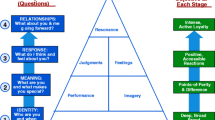Abstract
The paper “Conceptualizing, Measuring and Managing Customer-Based Brand Equity” in the Journal of Marketing by Keller (Journal of Marketing, 57(1), 1-22, 1993) on conceptualizing brand equity is path-breaking, and provided a much-needed organizing framework for the brand management topic. It is indeed an honor to be asked to provide a commentary on “Reflections on Customer-Based Brand Equity: Perspectives, Progress, and Priorities”. I articulate two separate ideas in writing this commentary: (1) Providing a critique of the framework described in Keller (Journal of Marketing, 57(1), 1-22, 1993); (2) Identifying promising new directions that can extend the framework and building on some of the suggestions provided in Keller (Academy of Marketing Science, 6 (1-2), 2016).
Similar content being viewed by others
References
Aggarwal, P. (2004). The effects of brand relationship norms on consumer attitudes and behavior. Journal of Consumer Research, 31(1), 87–101.
Aggarwal, P., & McGill, A. L. (2012). When brands seem human, do humans act like brands? Automatic behavioral priming effects of brand anthropomorphism. Journal of Consumer Research, 39(2), 307–323.
Ailawadi, K. L., Lehmann, D. R., & Neslin, S. A. (2003). Revenue premium as an outcome measure of brand equity. Journal of Marketing, 67(4), 1–17.
Bahadir, S. C., Bharadwaj, S. G., & Srivastava, R. K. (2008). Financial value of brands in mergers and acquisitions: is value in the eye of the beholder? Journal of Marketing, 72(6), 49–64.
Bharadwaj, S. G., Tuli, K. R., & Bonfrer, A. (2011). The impact of brand quality on shareholder wealth. Journal of Marketing, 75(5), 88–104.
Brakus, J., Schmitt, B. H., & Zaratonello, L. (2009). Brand experience: what is it? How is it measured? Does it affect loyalty? Journal of Marketing, 73(3), 52–68.
Brewer, M. B., & Gardner, W. (1996). Who is this ‘We’? Levels of collective identity and self representations. Journal of Personality and Social Psychology, 71(1), 83.
Broniarczyk, S. M., & Alba, J. W. (1994). The importance of the brand in brand extension. Journal of Marketing Research, 31(2), 214–228.
Chan, D., Berger, J., & Van Boven, L. (2011). Differentiating the ‘I’in ‘in-group’: How identity-signaling and uniqueness motives combine to drive consumer choice. Journal of Consumer Research. The University of Chicago Press. http://www.jstor.org/stable/10.1086/664804.
Chun, H. E. H., et al. (2015). Strategic benefits of low fit brand extensions: when and why? Journal of Consumer Psychology, 25(4), 577–595.
Cuddy, A. J. C., Fiske, S. T., & Glick, P. (2008). Warmth and competence as universal dimensions of social perception: the stereotype content model and the BIAS map. Advances in Experimental Social Psychology, 40, 61–149.
Dommer, S. L., Swaminathan, V., & Ahluwalia, R. (2013). Using differentiated brands to deflect exclusion and protect inclusion: the moderating role of self-esteem on attachment to differentiated brands. Journal of Consumer Research, 40(4), 657–675.
Erdem, T., Swait, J., Broniarczyk, S., Chakravarti, D., Kapferer, J. N., Keane, M., Roberts, J., Steenkamp, J. B. E. M., & Zettelmeyer, F. (1999). Brand equity, consumer learning and choice. Marketing Letters, 10(3), 301–318.
Fournier, S. (1998). Consumers and their brands: developing relationship theory in consumer research. Journal of Consumer Research, 24(4), 343–353.
Fournier, S., & Avery, J. (2011). The uninvited brand. Business Horizons, 54(3), 193–207.
Guadagni, P. M., & Little, J. D. C. (1983). A logit model of brand choice calibrated on scanner data. Marketing Science, 2(3), 203–238.
Gürhan-Canli, Z., & Maheswaran, D. (2000). Cultural variations in country of origin effects. Journal of Marketing Research, 37(3), 309–317.
Janiszewski, C., & van Osselaer, S. M. J. (2000). A connectionist model of brand–quality associations. Journal of Marketing Research, 37(3), 331–350.
Keller, K. L. (1993). Conceptualizing, measuring, managing customer-based brand equity. Journal of Marketing, 57(1), 1–22.
Keller, K. L. (2016). Reflections on customer-based brand equity: perspectives, progress and priorities. AMS Review, 6(1–2).
Keller, K. L., & Aaker, D. A. (1992). The effects of sequential introduction of brand extensions. Journal of marketing research, 35–50.
Keller, K. L., & Lehmann, D. (2001). The brand value chain: linking strategic and financial performance. Dartmouth College: Tuck School of Business.
Keller, K. L., & Sood, S. (2003). Brand equity dilution. MIT Sloan Management Review, 45(1), 12.
Kervyn, N., Fiske, S. T., & Malone, C. (2012). Brands as intentional agents framework: How perceived intentions and ability can map brand perception. Journal of Consumer Psychology, 22, 166–176.
Krishnan, M. S. (1996). Characteristics of memory associations: a consumer-based brand equity perspective. International Journal of Research in Marketing, 13(4), 389–405.
Kubat, U., & Swaminathan, V. (2015). Crossing the cultural divide through bilingual advertising: the moderating role of brand cultural symbolism. International Journal of Research in Marketing, 32(4), 354–362.
Kumar, N. (2005). The global retail challenge. Business Strategy Review, 16(1), 5–13.
Loken, B., & Roedder-John, D. (1993). Diluting brand beliefs: when do brand extensions have a negative impact? The Journal of Marketing, 57(July), 71–84.
Mizik, N., & Jacobson, R. (2008). The financial value impact of perceptual brand attributes. Journal of Marketing Research, 45(1), 15–32.
Mizik, N., & Jacobson, R. (2009). Valuing branded businesses. Journal of Marketing, 73(6), 137–153.
Monga, A. B., & Gürhan-Canli, Z. (2012). The influence of mating mind-sets on brand extension evaluation. Journal of Marketing Research, 49(4), 581–593.
Monga, A. B., & John, D. R. (2007). Cultural differences in brand extension evaluation: the influence of analytic versus holistic thinking. Journal of Consumer Research, 33(4), 529–536.
Morrin, M., & Ratneshwar, S. (2003). Does it make sense to use scents to enhance brand memory? Journal of Marketing Research, 40(1), 10–25.
Newmeyer, C., Swaminathan, V., & Hulland, J. S. (2016). When products and brands trade hands: Proposing a framework for acquisition success. Journal of Marketing Theory and Practice, forthcoming.
Roedder-John, D., Loken, B., & Joiner, C. (1998). The negative impact of extensions: can flagship products be diluted? Journal of Marketing, 62, 19–32.
Rust, R. T., Lemon, K. N., & Zeithaml, V. A. (2004). Return on marketing: using customer equity to focus marketing strategy. Journal of Marketing, 68(1), 109–127.
Schreier, M., Fuchs, C., & Dahl, D. W. (2012). The innovation effect of user design: exploring consumers’ innovation perceptions of firms selling products designed by users. Journal of Marketing, 76(5), 18–32.
Simon, C. J., & Sullivan, M. W. (1993). The measurement and determinants of brand equity: a financial approach. Marketing Science, 12(1), 28–52.
Swaminathan, V., Fox, R. J., & Reddy, S. K. (2001). The impact of brand extension introduction on choice. Journal of Marketing, 65(4), 1–15 (Lead Article).
Swaminathan, V., Page, K., & Gurhan-Canli, Z. (2007). My brand or our brand: individual-and group-based brand relationships and self-construal effects on brand evaluations. Journal of Consumer Research, 34(2), 248–259.
Swaminathan, V., Stilley, K., & Ahluwalia, R. (2009). When brand personality matters: the moderating role of attachment styles. Journal of Consumer Research, 35(6), 985–1002.
Swaminathan, V., Gürhan-Canli, Z., Kubat, U., & Hayran, C. (2015). How, when, and why do attribute-complementary versus attribute-similar cobrands affect brand evaluations: a concept combination perspective. Journal of Consumer Research, 42(1), 45–58.
Thomson, M. (2006). Human brands: investigating antecedents to consumers’ strong attachments to celebrities. Journal of Marketing, 70(3), 104–119.
Thomson, M., MacInnis, D. J., & Park, C. W. (2005). The ties that bind: measuring the strength of consumers’ emotional attachments to brands. Journal of Consumer Psychology, 15(1), 77–91.
Torelli, C. J., & Ahluwalia, R. (2012). Extending culturally symbolic brands: a blessing or a curse? Journal of Consumer Research, 38(5), 933–947.
Wedel, M., & Pieters, R. (2000). Eye fixations on advertisements and memory for brands: a model and findings. Marketing Science, 19(4), 297–312.
Author information
Authors and Affiliations
Corresponding author
Rights and permissions
About this article
Cite this article
Swaminathan, V. Branding in the digital era: new directions for research on customer-based brand equity. AMS Rev 6, 33–38 (2016). https://doi.org/10.1007/s13162-016-0077-0
Received:
Accepted:
Published:
Issue Date:
DOI: https://doi.org/10.1007/s13162-016-0077-0




